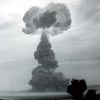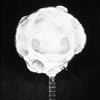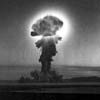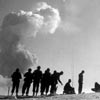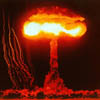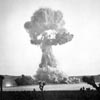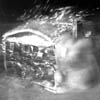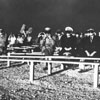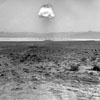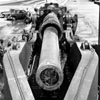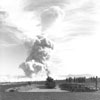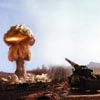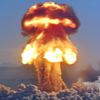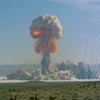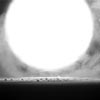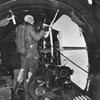
Badger - 18/04/1953
|
Operation Upshot-Knothole, like Operations Buster-Jangle and Tumbler-Snapper, was divided into two parts. Upshot dealt mainly with weapons development, while Knothole was primary concerned with weapons effects and civil defense.
Nine shots were fired at Yucca flat, seven tower shots and two airdrops. These were weapons development tests for the AEC, the Upshot phase of the operation. Knothole was primary conducted in conjunction with the two Frenchman Flat shots, Encore (May 8, 1953) and Grable (May 25, 1953). Both of those shots were air bursts, Encore was dropped from a B-50. Grable was the first and only test of an atomic device shot out of an artillery piece known as Atomic Annie.
There were many weapons development goals for the Upshot phase. These included proof tests for a number of tactical nuclear warheads and tests of radiation implosion systems which would be proof-tested in full scale thermonuclear tests the following year at the Pacific Proving Grounds under Operation Castle.
Extensive weapons effects tests were conducted under Knothole, over 70 in total. These included; shockwave precursor studies (first observed during Tumbler-Snapper Dog), blast and shock measurements, structure and material response to thermal radiation and blast, bio-medical experiments, and experiments involving drone aircraft.
Un-manned drone aircraft were used at a Nevada Test Site series for the first time under the Knothole phase. They were instrumented for blast and thermal radiation response and were flown at near critical distances from several bursts. Minimal safe operation parameters were also studies for high performance bombers. Several F-86 drone aircraft carried animals for gamma radiation studies for the bio-medical program. They were flown through atomic clouds at 9,140 meters. Manned fighter escorts flew ready to shoot down any drones that malfunctioned.
Parked aircraft and aircraft components were exposed to atomic blasts as part of the thermal effects program. Several different cloth thermal shields and fabrics were tested to determine survivability from various distances to zero point during the two Knothole shots.
Another important section of the thermal program was a study dealing with normal city vulnerability to fires started by atomic weapons. Three cubical houses 2,340 meters from ground zero were erected and exposed to the thermal pulse during shot Harry for study of external kindling fuels. This study was made famous in a film released by the U.S. government in 1954 titled The House in the Middle. It was selected for the 2002 National Film Registry of "artistically, culturally, and socially significant" films.
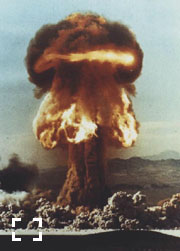
Grable - 25/05/1953
|
Precursor wave studies were a major section of the weapons effects study. A precursor is a shockwave that forms ahead of the mach stem, causing considerable more damage then a regular shockwave. Precursor waves were found to occur when dust on the ground is super heated by the fireball, this is called ‘Popcorning’. The heated air layer from the ‘Popcorning’ of the ground surface causes a precursor wave to form ahead of the main incident wave. A precursor wave can only form if the ground air layer is sufficiently heated. As altitude increased for an air burst, the yield must also increase to create a precursor wave.
Grable created a very strong precursor wave and took many of the weapons effects personnel by surprise as such damage resulting from the blast was not predicted. Structures and vehicles that were simply overturned during the Encore event were shattered and destroyed during the Grable event. Encore had a greater yield then Grable, almost twice as strong, but did far less damage due to the higher burst height.
Thermal radiation effects filtered through white and black smoke was another section of the thermal effects study conducted during Grable. In theory, the smoke would scatter and reflect fireball heat. The smoke experiment, however, was handicapped by strong winds that modified the planned geometry of the smoke. The smoke was lifted to between 60 and 90 meters, this increased the power of the precurser but reduced the distance it extended by half.
Another notable test during this series was shot Climax which proof tested the MK-7, the most compact implosion bomb design yet developed. This weapon had a small diameter making it suitable for external carriage by high speed fighter-bombers. The test name was mnemonic code for "Cobra". The yield of 61kt was the highest of any U.S. continental test up to this time. The composite Cobra primary was later essential in several thermonuclear devices in the Castle test series, namely the Shrimp, Runt 1/2 and Alarm Clock devices. The smoke trails visible in this and other tests are actually left by small rockets just before the detonation to help analyse the blastwave.
These were some of the weapons effects experiments done under the Knothole phase. Most were continuations of previous studies but many were conducted for the first time and were further tested during subsequent tests.
An estimated 18,000 DOD personnel participated in observer programs, tactical maneuvers, scientific studies, and support activities. Members of all four armed services participated in Exercise Desert Rock V.
This operation exposed exercise personnel to nuclear tests, and thus radiation, more aggressively than previous ones. Observation by troop formations was conducted at what was (at the time) calculated to be the minimum safe separation distance, with many personnel being exposed to multiple tests. Under current occupational radiation exposure limits (0.3 rem/week and 5 rem/year) this would would limit maximum exposures to 3.3 rems over the 11 week operation. Approximately three thousand soldiers reached or exceeded this limit, with 84 exceeding the annual limit (the highest recorded exposure was 26.6 rem). These exposures do not produce observable symptoms, they simply increase the lifetime risk of cancer a small amount.
The effect on the downwind civilian population was much worse. Uphot-Knothole released some 35,000 kilocuries of radioiodine into the atmosphere (for comparison, Trinity released about 3200 kilocuries of radioiodine).
Shot nine of the series Harry was notable in that it resulted in the heaviest contamination of downwinders of any U.S. continental test. The radioactive cloud rose to an altitude of 11,500 meters and passed directly over St. George, Utah, 160 km to the east. The following summer film 'The Conqueror' starring John Wayne, was shot in a canyon near St. George. Legend has it that he developed cancer, and later died, due to this test. 91 members of the 220 member cast developed cancer. For these reasons, the test came to be known as 'Dirty Harry'.
Up until 1958, it is estimated that a cumulative total of 85,000 person-roentgens of external gamma ray exposure occurred since the beginning of testing in the continental United States. Of this, Harry contributed 30,000 by itself.
|
- Click on a thumbnail for a larger version
|
Test Shots
| Video |
Name |
Yield |
Date |UTC| |
Type |
Warhead |
Location |
LAT/LONG |
 |
Annie |
16 kt |
13:20 17/03/1953 |
Tower @90m |
Mk-5 |
NTS Area 3 |
37.04780 -116.02110 |
 |
Nancy |
24 kt |
13:10 24/03/1953 |
Tower @90m |
TX-15 |
NTS Area 4 |
37.09560 -116.10280 |
 |
Ruth |
0.2 kt |
13:00 31/03/1953 |
Tower @90m |
- |
NTS Area 7 |
37.08280 -116.02390 |
 |
Dixie |
11 kt |
15:29 06/04/1953 |
Airdrop @1830m |
Mk-5D |
NTS Area 7 |
37.08470 -116.01800 |
 |
Ray |
0.2kt |
12:45 11/04/1953 |
Tower @30m |
- |
NTS Area 4 |
37.09890 -116.09250 |
 |
Badger |
23 kt |
12:35 18/04/1953 |
Tower @90m |
TX-16 |
NTS Area 2 |
37.13830 -116.11780 |
 |
Simon |
43 kt |
12:30 25/04/1953 |
Tower @90m |
TX-17/24 |
NTS Area 1 |
37.05310 -116.10280 |
 |
Encore |
27 kt |
15:30 08/05/1953 |
Airdrop @740m |
Mk-6D |
NTS Area 5 |
36.80000 -115.92890 |
 |
Harry |
32 kt |
12:05 19/05/1953 |
Tower @90m |
TX-13D |
NTS Area 3 |
37.04030 -116.02530 |
 |
Grable |
15 kt |
15:30 25/05/1953 |
Airburst @159m |
Mk-9 AFAP |
NTS Area 5 |
36.79310 -115.91470 |
 |
Climax |
61 kt |
11:14 04/06/1953 |
Airdrop @410m |
Mk-7 |
NTS Area 7 |
37.08750 -116.01830 |

| - DNA 6014F - Defense Nuclear Agency report - Upshot-Knothole
|

| - DNA 6015F - Defense Nuclear Agency report - Upshot-Knothole - Badger
|

| - DNA 6016F - Defense Nuclear Agency report - Upshot-Knothole - Simon
|

| - DNA 6018F - Defense Nuclear Agency report - Upshot-Knothole - Encore to Climax
|
|







